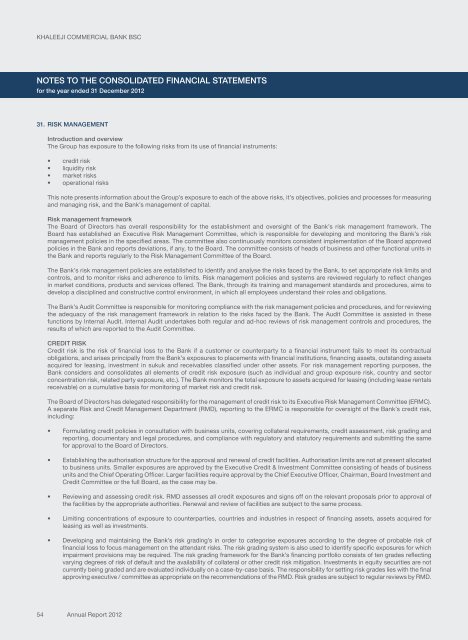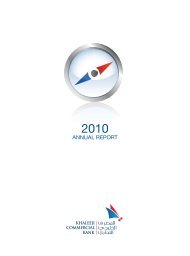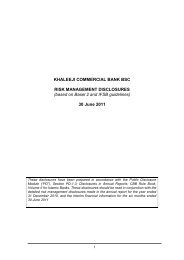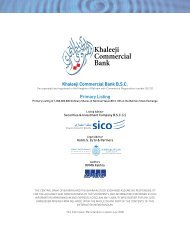2012 Annual Report - Financial Statements (English) - Khaleeji ...
2012 Annual Report - Financial Statements (English) - Khaleeji ...
2012 Annual Report - Financial Statements (English) - Khaleeji ...
You also want an ePaper? Increase the reach of your titles
YUMPU automatically turns print PDFs into web optimized ePapers that Google loves.
KHALEEJI COMMERCIAL BANK BSCNOTES TO THE CONSOLIDATED FINANCIAL STATEMENTSfor the year ended 31 December <strong>2012</strong>31. RISK MANAGEMENTIntroduction and overviewThe Group has exposure to the following risks from its use of financial instruments:• credit risk• liquidity risk• market risks• operational risksThis note presents information about the Group’s exposure to each of the above risks, it’s objectives, policies and processes for measuringand managing risk, and the Bank’s management of capital.Risk management frameworkThe Board of Directors has overall responsibility for the establishment and oversight of the Bank’s risk management framework. TheBoard has established an Executive Risk Management Committee, which is responsible for developing and monitoring the Bank’s riskmanagement policies in the specified areas. The committee also continuously monitors consistent implementation of the Board approvedpolicies in the Bank and reports deviations, if any, to the Board. The committee consists of heads of business and other functional units inthe Bank and reports regularly to the Risk Management Committee of the Board.The Bank’s risk management policies are established to identify and analyse the risks faced by the Bank, to set appropriate risk limits andcontrols, and to monitor risks and adherence to limits. Risk management policies and systems are reviewed regularly to reflect changesin market conditions, products and services offered. The Bank, through its training and management standards and procedures, aims todevelop a disciplined and constructive control environment, in which all employees understand their roles and obligations.The Bank’s Audit Committee is responsible for monitoring compliance with the risk management policies and procedures, and for reviewingthe adequacy of the risk management framework in relation to the risks faced by the Bank. The Audit Committee is assisted in thesefunctions by Internal Audit. Internal Audit undertakes both regular and ad-hoc reviews of risk management controls and procedures, theresults of which are reported to the Audit Committee.CREDIT RISKCredit risk is the risk of financial loss to the Bank if a customer or counterparty to a financial instrument fails to meet its contractualobligations, and arises principally from the Bank’s exposures to placements with financial institutions, financing assets, outstanding assetsacquired for leasing, investment in sukuk and receivables classified under other assets. For risk management reporting purposes, theBank considers and consolidates all elements of credit risk exposure (such as individual and group exposure risk, country and sectorconcentration risk, related party exposure, etc.). The Bank monitors the total exposure to assets acquired for leasing (including lease rentalsreceivable) on a cumulative basis for monitoring of market risk and credit risk.The Board of Directors has delegated responsibility for the management of credit risk to its Executive Risk Management Committee (ERMC).A separate Risk and Credit Management Department (RMD), reporting to the ERMC is responsible for oversight of the Bank’s credit risk,including:• Formulating credit policies in consultation with business units, covering collateral requirements, credit assessment, risk grading andreporting, documentary and legal procedures, and compliance with regulatory and statutory requirements and submitting the samefor approval to the Board of Directors.• Establishing the authorisation structure for the approval and renewal of credit facilities. Authorisation limits are not at present allocatedto business units. Smaller exposures are approved by the Executive Credit & Investment Committee consisting of heads of businessunits and the Chief Operating Officer. Larger facilities require approval by the Chief Executive Officer, Chairman, Board Investment andCredit Committee or the full Board, as the case may be.• Reviewing and assessing credit risk. RMD assesses all credit exposures and signs off on the relevant proposals prior to approval ofthe facilities by the appropriate authorities. Renewal and review of facilities are subject to the same process.• Limiting concentrations of exposure to counterparties, countries and industries in respect of financing assets, assets acquired forleasing as well as investments.• Developing and maintaining the Bank’s risk grading’s in order to categorise exposures according to the degree of probable risk offinancial loss to focus management on the attendant risks. The risk grading system is also used to identify specific exposures for whichimpairment provisions may be required. The risk grading framework for the Bank’s financing portfolio consists of ten grades reflectingvarying degrees of risk of default and the availability of collateral or other credit risk mitigation. Investments in equity securities are notcurrently being graded and are evaluated individually on a case-by-case basis. The responsibility for setting risk grades lies with the finalapproving executive / committee as appropriate on the recommendations of the RMD. Risk grades are subject to regular reviews by RMD.54<strong>Annual</strong> <strong>Report</strong> <strong>2012</strong>










